Cambodia eVisa vs. Visa on Arrival: What’s the Best Option?
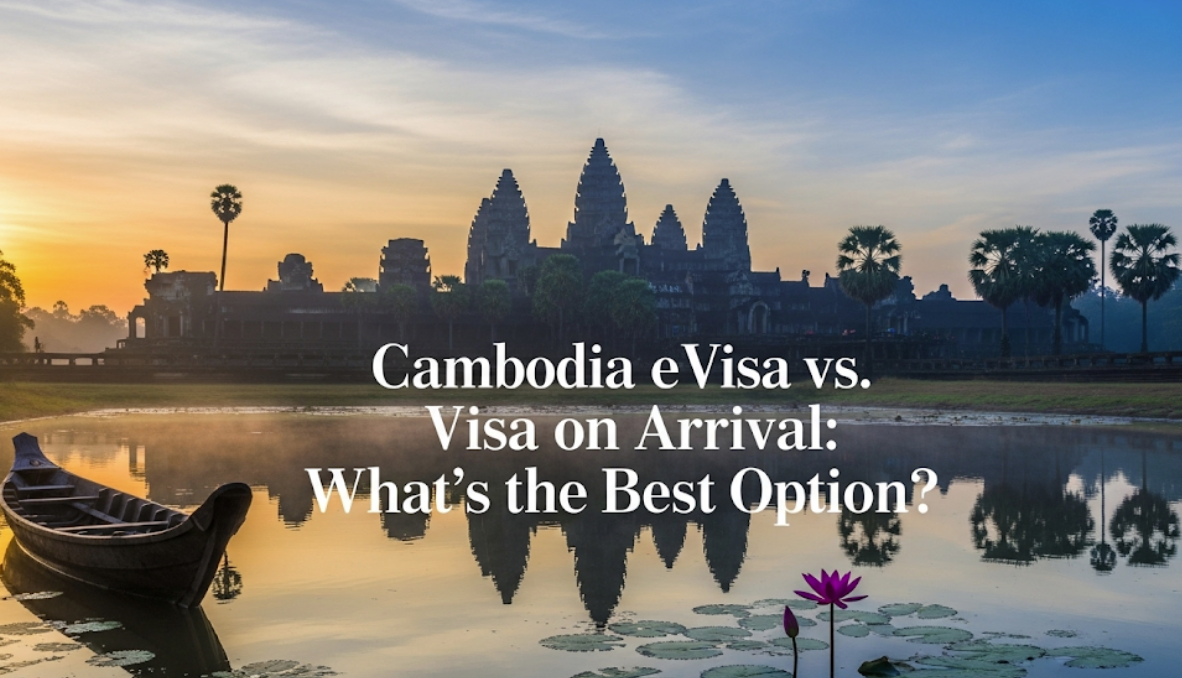
Many people dream of travelling to Cambodia. The country is a beautiful blend of culture, history, natural beauty, and awe-inspiring temples, starting with the Angkor Wat temples and ending with serene countryside and the busy city such as Phnom Penh. But, the first thing that you need to decide before starting your Cambodian adventure is how you will legally enter the country. There are two major visa options available to international travelers in Cambodia which include the Cambodia eVisa and Visa on Arrival (VOA). Both have their pros and cons, and your decision can have a great impact on your experience traveling.
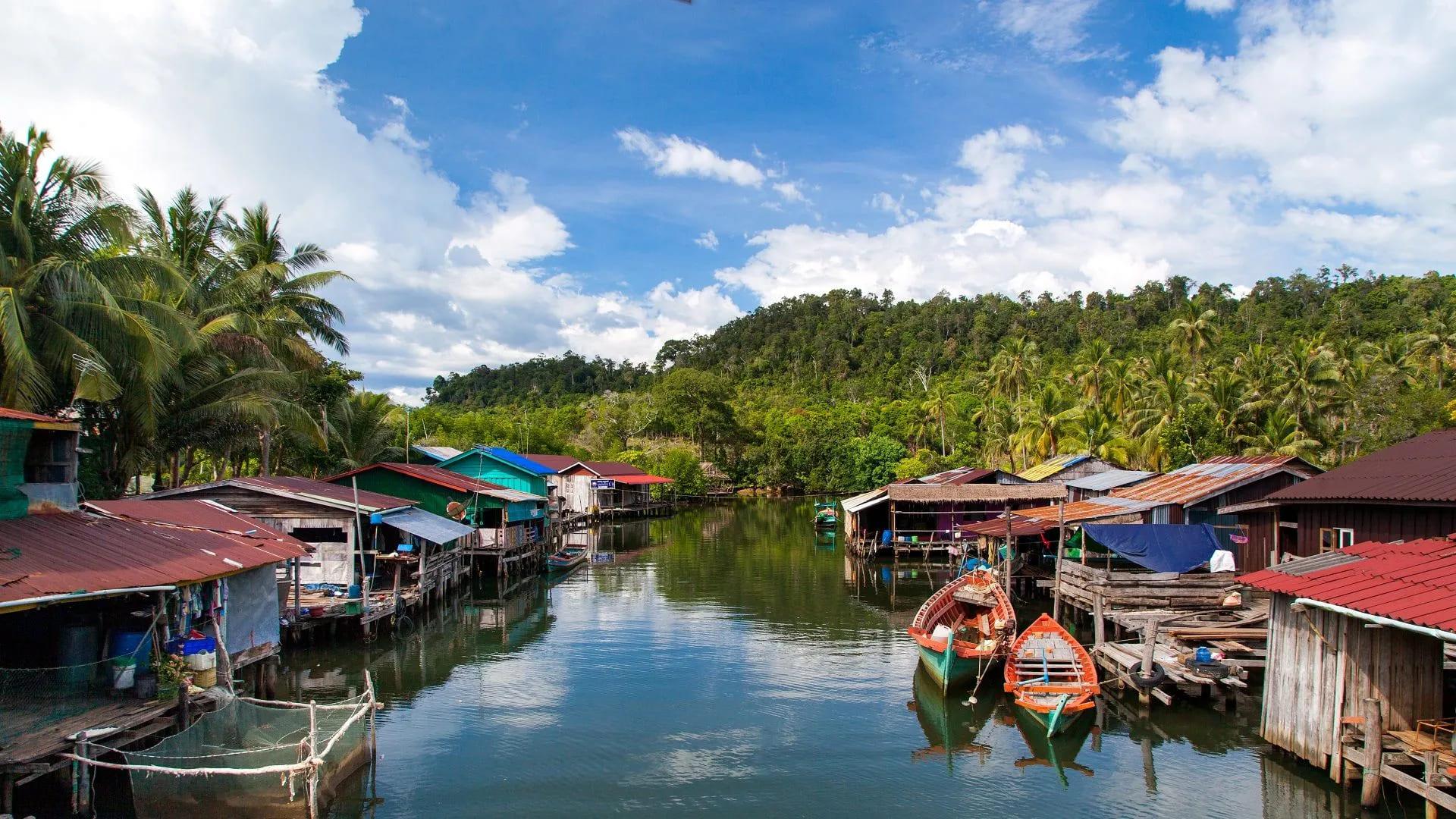
Cambodia eVisa: The Stress-Free Option
The Cambodia eVisa refers to an e-visa that is requested online prior to your visit. It targets passengers with a hassle-free predictable arrival experience. The eVisa is attractive because of the following:
Key Benefits of eVisa
-
Convenience: Apply from the comfort of your home or office. The online application form is simple and takes only about 10–15 minutes.
-
Time-saving: Since your visa is approved in advance, you can skip long lines at the airport, making your arrival stress-free.
-
Secure payment: Fees are paid online using a credit or debit card, eliminating the need to carry cash.
-
Quick processing: Most eVisa applications are approved within 2–3 business days.
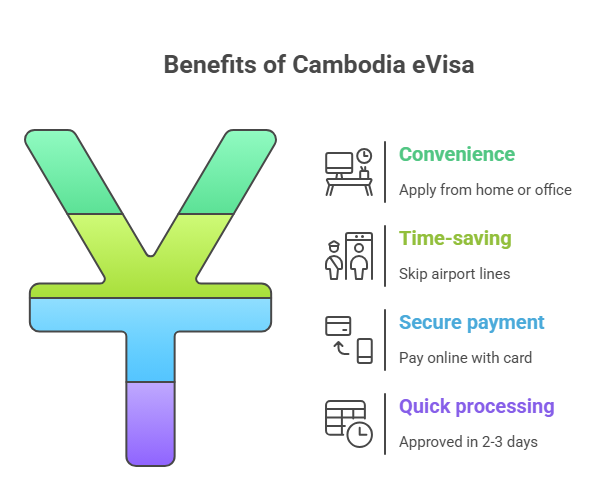
Practical Tips for eVisa Applicants
-
Make sure your passport is valid for at least six months from the date of entry.
-
Keep a digital copy of your eVisa on your phone and a printed copy as a backup.
-
Apply at least one week before travel to account for any unexpected delays.
The eVisa gives a maximum duration of 30 days of stay and it takes 90 days to enter the country. This is a particularly easy way of visitors or travelers who like doing it beforehand.
Visa on Arrival: Flexible but Unpredictable
Another option is Visa on Arrival (VOA), which permits the traveler to get his or her visa at Cambodian airports or at specific land border crossings. Travelers who make spur-of-the-moment arrangements or come to Cambodia by land use it constantly.
Advantages of VOA
-
No pre-planning required: Ideal for last-minute trips.
-
Available at multiple entry points: VOA is accepted at airports in Phnom Penh, Siem Reap, Sihanoukville, and several land borders.
-
Flexibility for travelers crossing by land: Especially convenient for those traveling from Thailand, Vietnam, or Laos.
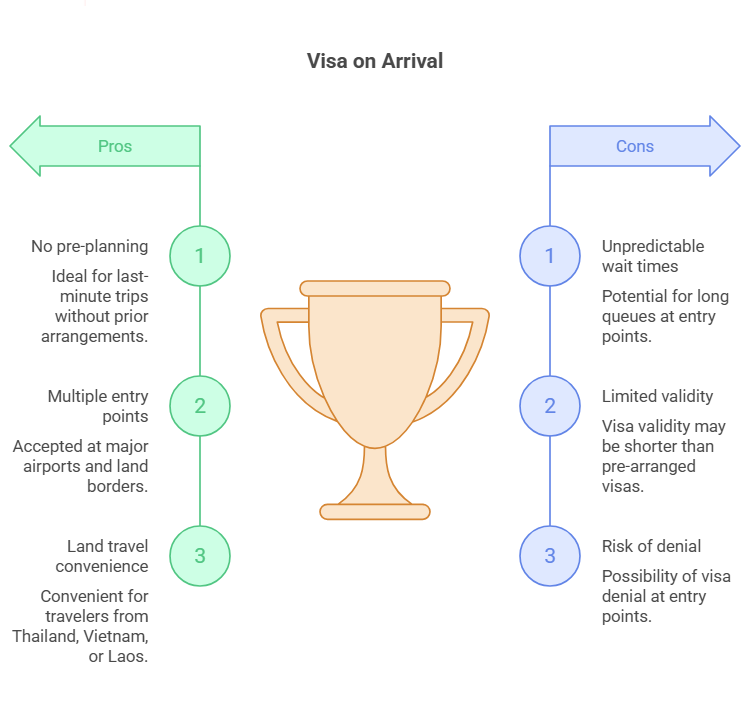
Drawbacks of VOA
-
Long queues: During peak tourist season, waiting times can exceed one hour.
-
Document requirements: Travelers must provide passport-sized photos and pay in USD cash.
-
Risk of delays or denial: Missing documents or incomplete forms can create complications.
Although VOA is spontaneous, it can be a source of unwarranted stress to first-time visitors or travelers with a tight agenda.
Detailed Comparison: Cambodia eVisa vs. Visa on Arrival
|
Feature |
Cambodia eVisa |
Visa on Arrival |
|
Application |
Online before travel |
At airport or border |
|
Processing Time |
2–3 business days |
Immediate but may involve queues |
|
Payment |
Online (credit/debit card) |
Cash in USD |
|
Entry Points |
Airports only |
Airports and select land borders |
|
Convenience |
High |
Moderate |
|
Preparation Needed |
Passport, photo, online form |
Passport, photo, cash, form |
|
Stress Level |
Low |
Moderate to high depending on queue |
This table helps travelers quickly see which option suits their style.
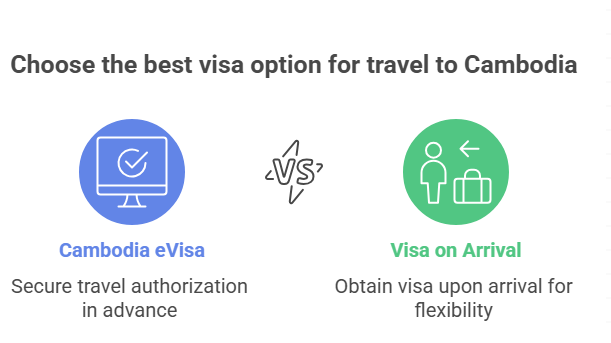
When to Choose Each Option
-
Choose Cambodia eVisa if:
-
You want a smooth, hassle-free entry.
-
You are entering via an airport.
-
You prefer to plan ahead and avoid queues.
-
Choose Visa on Arrival if:
-
You are crossing land borders.
-
Your travel plans are spontaneous.
-
You are comfortable waiting in line and paying cash in USD.
Step-by-Step Guide to Applying for the e-Visa
-
Complete the Online Form – Enter your personal information, passport details, and travel dates accurately to avoid delays.
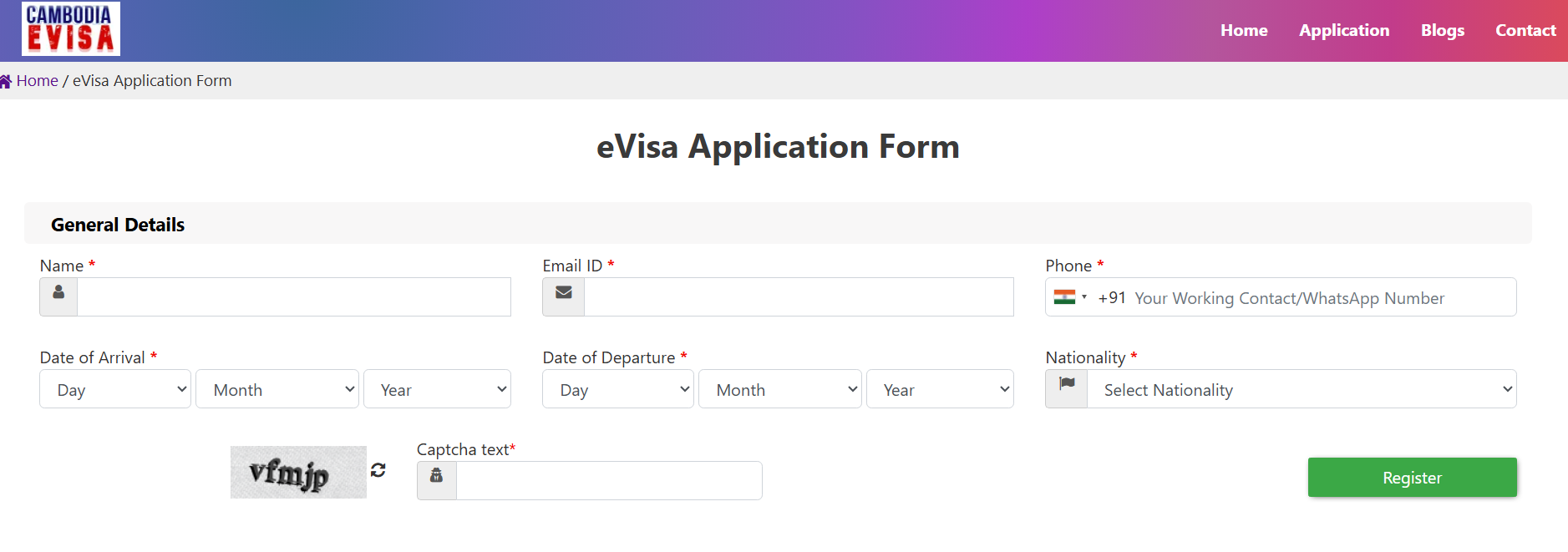
-
Upload Required Documents – Ensure all items meet the document requirements for Cambodia e-visa, including a recent passport photo and a valid passport.
-
Pay the Visa Fee – Submit the Cambodia e-visa fee securely online. Keep a record of the payment confirmation for your records.
-
Receive Your e-Visa – After processing, usually within 1–3 business days, you will receive your e-Visa via email. Print a copy to present at the entry point.
-
Prepare for Travel – Carry the printed e-Visa along with your passport and travel documents to ensure a smooth entry into Cambodia.
Document Requirements for Cambodia e-Visa
Travelers must ensure they meet the document requirements for Cambodia e-visa, which typically include:
-
A valid passport with at least six months validity
-
A recent passport-sized photo
-
A confirmed travel plan
-
Payment confirmation of the Cambodia e-visa fee
Having all documents ready reduces the chances of delays or rejection.
Insider Tips for a Smooth Entry
-
Arrive early at immigration: Whether using eVisa or VOA, arriving early reduces waiting time.
-
Have small USD bills ready: VOA requires cash, and smaller bills make the process faster.
-
Keep documents handy: Passport, eVisa printout, photos, and payment ready before reaching the counter.
-
Check validity: Ensure your passport is valid for at least six months and your visa aligns with your travel plans.
-
Plan for peak seasons: Cambodia sees high tourist traffic from November to February, so lines can be longer during these months.
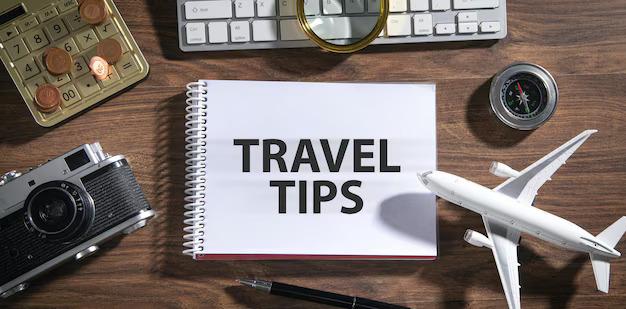
Conclusion
The choice between Cambodia eVisa or Visa on Arrival is determined mostly by your mode of travel. The eVisa will be the most secure option in case you respect the convenience, speed, and peace of mind. Via the waterways Visa on Arrival may be a good option, although it demands a bit of planning and time.
Knowing these possibilities, planning in advance and preparing the necessary papers can help you enter Cambodia smoothly and devote your time to exploring its interesting culture, amazing temples, and lively cities.
FAQs About Cambodia eVisa and Visa on Arrival
Q1: Can I enter Cambodia multiple times with an eVisa?
No. The standard eVisa allows single entry only. Multiple-entry visas are available through a separate application process.
Q2: How long does it take to get an eVisa?
Processing usually takes 2–3 business days, but it’s recommended to apply at least one week before traveling.
Q3: Can I pay for Visa on Arrival with a card?
Most VOA fees require cash in USD, preferably in small denominations for convenience.
Q4: Can eVisa be used at land borders?
No. The eVisa is valid only at major airports. For land crossings, Visa on Arrival is required.
Q5: What documents are needed for Visa on Arrival?
You need a passport with six months validity, passport-sized photos, completed application forms, and USD cash for the fee.
Q6: What happens if I lose my eVisa during travel?
Always carry a digital copy and printed copy. Immigration authorities can usually verify your eVisa electronically, but having a backup reduces stress.
- Art
- Causes
- Crafts
- Dance
- Drinks
- Film
- Fitness
- Food
- Oyunlar
- Gardening
- Health
- Home
- Literature
- Music
- Networking
- Other
- Party
- Religion
- Shopping
- Sports
- Theater
- Wellness




